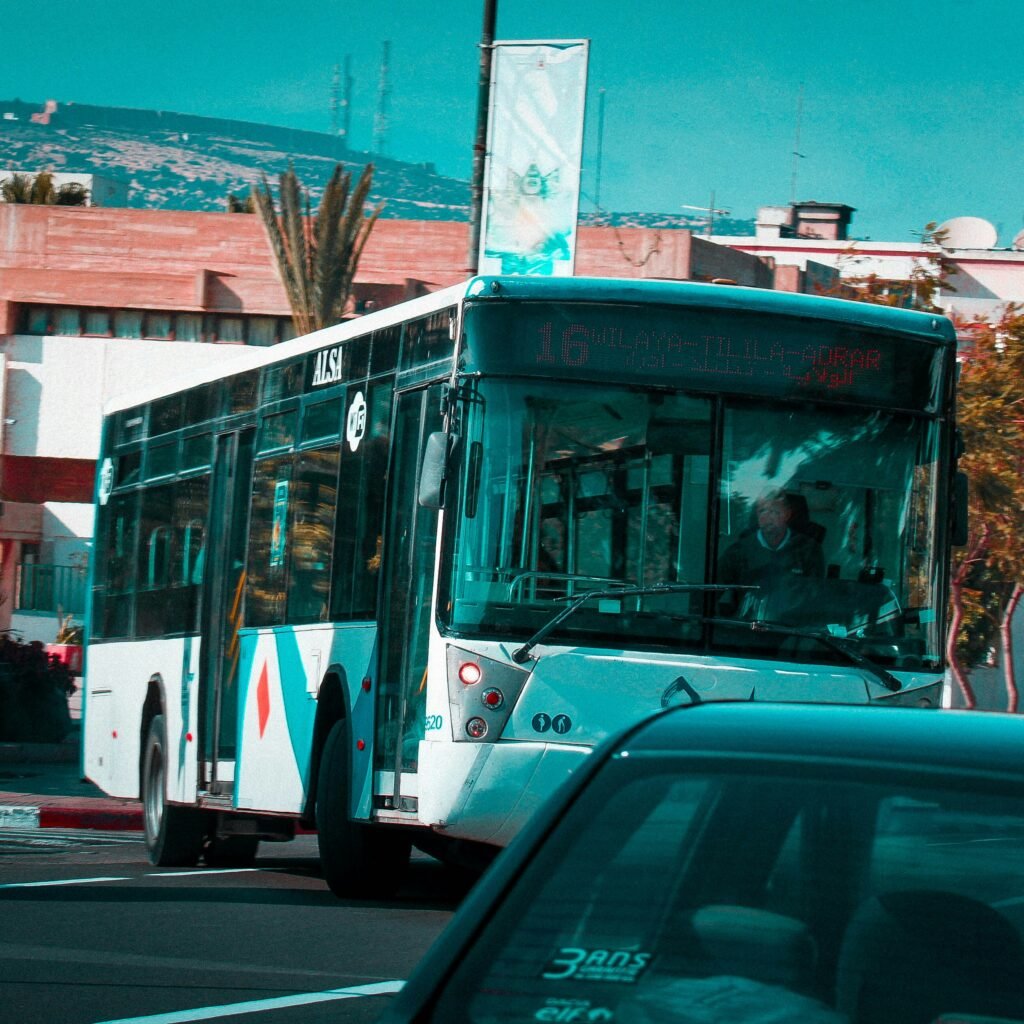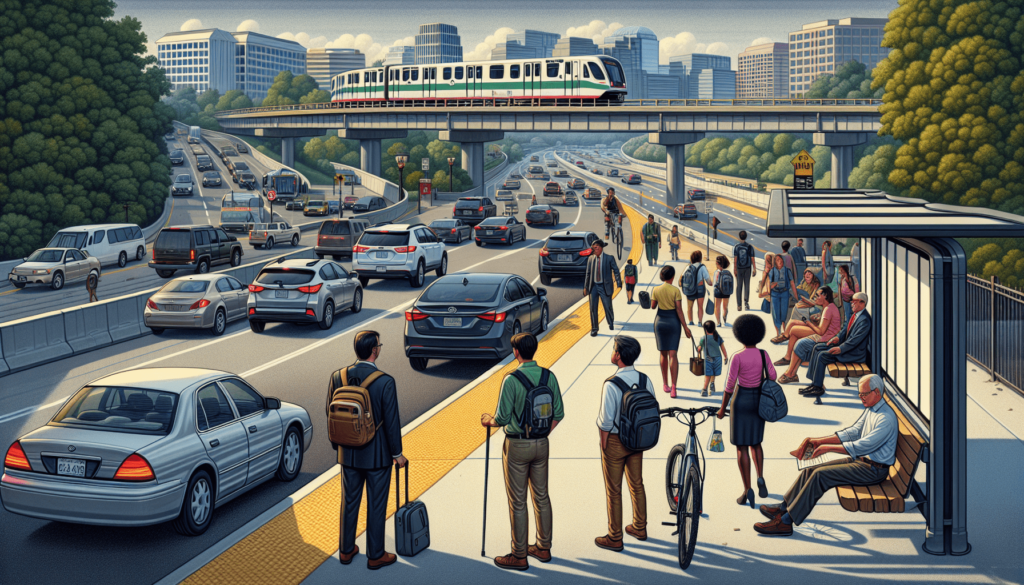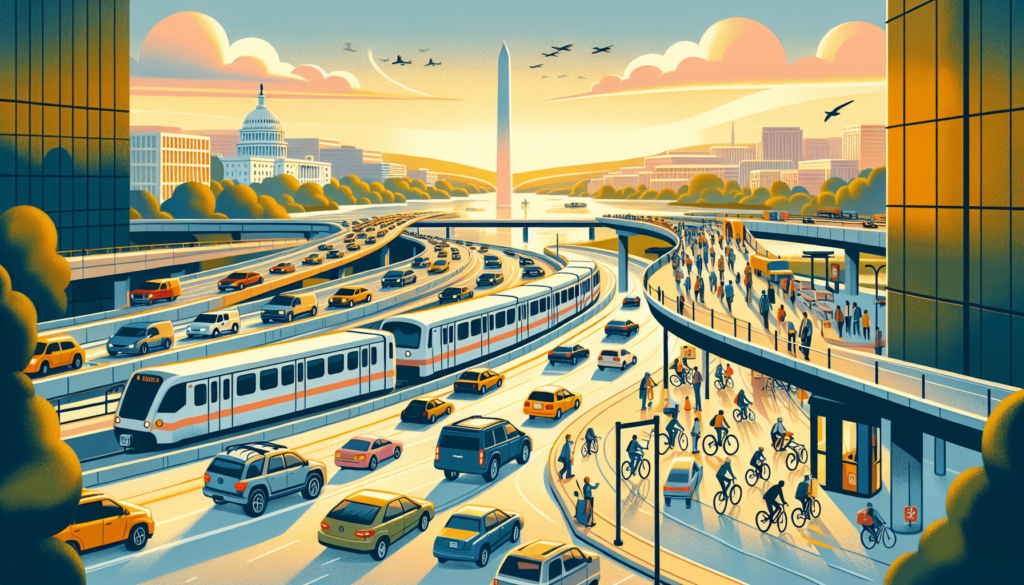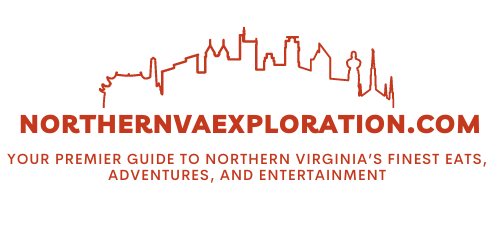Living in Northern Virginia and needing to commute to Washington, D.C. can be quite the challenge. I am constantly on the lookout for efficient and convenient transportation options to make my daily commute smoother. With countless commuters in the region, it’s essential to have a solid understanding of the transportation options available to ensure a stress-free journey. From reliable metro lines to reliable bus services, I will explore the various modes of transportation that make getting to the nation’s capital a breeze.

Overview of the Commute
Distance and Time
The commute from Northern Virginia to Washington, D.C. can vary depending on the specific location and transportation option chosen. On average, the distance between these two regions is around 10 to 20 miles. The duration of the commute largely depends on the mode of transportation used, traffic conditions, and peak commute hours.
Traffic Patterns
Northern Virginia is known for its bustling traffic, especially during peak commute hours. Major highways and interstates can become congested, leading to longer travel times. Understanding traffic patterns and planning the commute accordingly can help minimize delays and frustration.
Peak Commute Hours
Peak commute hours in Northern Virginia usually occur from 6:30 AM to 9:30 AM and 3:30 PM to 7:00 PM. During these times, roads and highways experience heavy traffic congestion, significantly increasing commute times. It’s advisable to plan travel outside of these rush hours, if possible, to avoid the worst traffic.
Seasonal Variations
Seasonal variations can also impact the commute. Inclement weather, such as snowstorms or heavy rain, can lead to delays and hazardous driving conditions. It’s important to stay informed about weather forecasts and adjust travel plans accordingly to ensure a safe and efficient commute.
Transportation Infrastructure
The transportation infrastructure in Northern Virginia is well-developed, consisting of interstate highways, toll roads, public transportation systems, bike lanes, and pedestrian walkways. These infrastructure elements provide commuters with various options to choose from when deciding how to travel to Washington, D.C.
Driving
Interstate Highways
Interstate highways, such as I-66, I-95, and I-395, are major routes connecting Northern Virginia to Washington, D.C. These highways offer direct and efficient access to the city, but they can also become congested during peak commute hours. It’s crucial to monitor traffic conditions and plan the commute accordingly to ensure a smoother driving experience.
Toll Roads
Toll roads, including the Dulles Toll Road and the Capital Beltway (I-495), provide an alternate option for commuters. They offer faster travel times in exchange for a toll fee. Utilizing toll roads can help avoid heavy traffic on regular routes, particularly during peak hours.
HOV Lanes
High Occupancy Vehicle (HOV) lanes are designated lanes on major highways, including I-66, I-95, and I-395, where vehicles with multiple occupants can travel at higher speeds with less congestion. Carpooling or using public transportation allows access to these lanes, providing a faster commute by bypassing regular traffic lanes.
Parking Facilities
Washington, D.C. has numerous parking facilities available for commuters. Whether utilizing parking garages or parking meters, it’s essential to familiarize oneself with the parking regulations, costs, and availability in the chosen destination area to ensure a hassle-free parking experience.
Carpooling
Carpooling is a popular and eco-friendly option for commuting from Northern Virginia to Washington, D.C. By sharing a ride with others, commuters can reduce traffic congestion, save on fuel costs, and enjoy a more sociable commute. Various online platforms and organizations facilitate carpool matching, making it easier to find compatible co-passengers.
Public Transportation
Metrorail
The Metrorail system, operated by the Washington Metropolitan Area Transit Authority (WMATA), is a highly efficient and widely used mode of public transportation in the D.C. metropolitan area. Multiple Metrorail lines connect Northern Virginia to the city, providing a convenient and reliable means of commuting. Commuters can purchase fare cards or use mobile payment options for easy access to Metrorail services.
Virginia Railway Express (VRE)
The Virginia Railway Express (VRE) is a commuter rail service that operates between Northern Virginia and Washington, D.C. VRE provides comfortable and stress-free travel, allowing commuters to relax or work during the journey. With multiple stations in both regions, VRE offers a viable transportation option for those looking to avoid the hassles of driving.
Bus Services
Bus services are another popular means of public transportation in Northern Virginia. Several bus routes operate between different neighborhoods and Washington, D.C. The availability of both local and express bus services provides commuters with flexible options to suit their specific travel needs. It’s important to check schedules and plan accordingly to ensure timely arrivals and departures.
Fares and Passes
Depending on the chosen public transportation option, fares and passes may vary. Metrorail and bus fare structures differ, with options for single rides, daily passes, and weekly or monthly passes. Students, seniors, and individuals with disabilities may be eligible for discounted fares. It’s recommended to explore the available fare options and choose the most cost-effective solution for regular commuting.
Accessible Transportation
Public transportation systems in Northern Virginia and Washington, D.C. prioritize accessibility for individuals with disabilities. Metrorail and buses have accommodations such as ramps, elevators, accessible seating, and audio/visual announcements. Commuters with accessibility needs can rely on these services to ensure a smooth and inclusive commuting experience.
Cycling
Bike Lanes and Trails
Northern Virginia offers an extensive network of bike lanes and trails, making cycling a viable commuting option. Dedicated bike lanes alongside major roads and off-road trails provide safe and efficient routes for cyclists. Commuters can enjoy scenic rides while avoiding traffic congestion and contributing to a greener environment.
Bike Sharing Programs
Bike-sharing programs, such as Capital Bikeshare, offer short-term rental options for individuals who prefer cycling but don’t own a bike. With numerous docking stations throughout Northern Virginia and D.C., commuters can easily rent a bike, complete their journey, and return it at any convenient location. Bike-sharing programs promote sustainable transportation and offer flexibility for short-distance commutes.
Bicycle Parking
To facilitate bicycle commuting, there are designated bike parking facilities available throughout Northern Virginia and Washington, D.C. These facilities include bike racks, bike lockers, and secure bike rooms. Cyclists can secure their bikes while at work or exploring the city, ensuring the safety of their mode of transportation.

Walking
Sidewalks
Both Northern Virginia and Washington, D.C. have well-maintained sidewalks, providing safe and convenient paths for pedestrians. Sidewalks allow commuters to walk comfortably, whether for short distances or as part of a longer journey. It’s important to familiarize oneself with local pedestrian regulations, such as yielding to traffic at intersections, to ensure a safe and pleasant walking experience.
Pedestrian Crossings
Pedestrian crossings, such as crosswalks and pedestrian signals, are strategically located throughout both regions. These crossings enhance pedestrian safety, allowing commuters to navigate busy intersections and roadways. Adhering to traffic signals and crosswalk regulations is crucial for pedestrian safety and the smooth flow of traffic.
Safe Routes
Safe Routes to School and Safe Routes to Work initiatives promote pedestrian safety and encourage walking as a commuting option. These programs identify safe routes with proper sidewalks, crossings, and reduced traffic volume. By following designated safe routes, commuters can enjoy a stress-free walk while avoiding potential hazards.
Walking Tours
For those interested in exploring the city, walking tours provide an excellent opportunity to experience the vibrant culture and history of Washington, D.C. Various guided or self-guided tours cover popular landmarks, monuments, and neighborhoods, offering a unique way to commute and immerse oneself in the city’s rich heritage.
Alternative Commute Options
Vanpooling
Vanpooling is a cost-effective and eco-friendly alternative for commuting from Northern Virginia to Washington, D.C. A group of individuals who live and work in the same area can share a van, reducing costs and minimizing the number of vehicles on the road. Vanpool services often provide comfortable and convenient transportation options, allowing commuters to relax or work during the journey.
Telecommuting
Telecommuting, or working remotely, has gained popularity in recent times, particularly due to technological advancements and the flexibility it offers. Many employers now provide options for employees to work from home, eliminating the need for a physical commute. Telecommuting helps reduce traffic congestion and provides a more flexible work-life balance.
Flextime
Flextime allows employees to have flexibility in their work schedules. Instead of adhering to strict 9-to-5 hours, individuals can choose their start and end times within a predefined range. This flexibility allows commuters to avoid peak traffic hours and customize their daily commute to Washington, D.C. accordingly.
Compressed Workweeks
Compressed workweeks involve working longer hours over fewer days in a week. Examples include working four 10-hour days instead of five 8-hour days. This alternative scheduling arrangement reduces the number of commutes made per week, resulting in reduced traffic congestion and increased productivity for employees.
Ridesharing Services
Uber
Uber is a popular ridesharing service available in Northern Virginia and Washington, D.C. Commuters can request a ride through the Uber app, and a driver will pick them up from their designated location. Uber offers a convenient and flexible transportation option, ensuring a comfortable and reliable commute to the city.
Lyft
Lyft is another well-known ridesharing platform that operates in Northern Virginia and Washington, D.C. Similar to Uber, Lyft allows commuters to request rides through the app, offering competitive pricing and reliable service. Commuters can enjoy a stress-free ride, letting the driver handle navigation and parking while focusing on their tasks or leisure activities.
ZTrip
ZTrip is a popular taxi and ridesharing service operating in Northern Virginia and Washington, D.C. With a range of vehicle options and professional drivers, ZTrip provides reliable and efficient transportation for commuters. The ZTrip app allows passengers to schedule rides in advance, ensuring a seamless and convenient commute experience.
Ride Sharing Regulations
Ridesharing services in Northern Virginia and Washington, D.C. operate under specific regulations to ensure passenger safety and fair business practices. These regulations dictate driver requirements, including background checks, insurance coverage, and vehicle inspections. Familiarizing oneself with the rules and regulations can help commuters make informed choices when utilizing ridesharing services.
Park and Ride Facilities
Locations
Park and Ride facilities are strategically located throughout Northern Virginia, providing convenient options for commuters. These facilities typically offer parking spaces for personal vehicles, as well as bike racks and designated areas for shuttle bus services. Park-and-ride lots are usually located near major highways and public transportation hubs, making it easier for commuters to transition between modes of transportation.
Costs
The costs associated with park-and-ride facilities can vary depending on the location and duration of parking. Some facilities offer free parking, while others charge a nominal fee. It’s important to check the specific costs and payment options before using a park-and-ride facility to avoid any surprises or inconveniences.
Facilities and Services
Park and Ride facilities often provide additional amenities and services to enhance the commuting experience. These may include restrooms, bike lockers, carpool matching services, and shuttle buses connecting to nearby transit stations. By utilizing these facilities, commuters can seamlessly transition between driving and public transportation, reducing the overall commute time and alleviating parking concerns.

Commuter Benefits Programs
Employer-provided Benefits
Many employers in Northern Virginia and Washington, D.C. understand the challenges of commuting and offer various commuter benefits to their employees. These benefits may include subsidies or pre-tax savings for public transportation passes, flexible work arrangements, telecommuting options, or assistance with vanpool programs. Taking advantage of these employer-provided benefits can significantly reduce commuting costs and enhance the overall work-life balance.
Pre-Tax Commuter Benefits
Pre-tax commuter benefits allow employees to use pre-tax dollars to pay for eligible commuting expenses, such as public transportation fares or parking fees. These benefits can result in substantial tax savings for commuters, making their daily commute more affordable. It’s advisable to check with the employer’s human resources department to understand the available pre-tax commuter benefit options.
Transportation Management Associations
Transportation Management Associations (TMAs) play a crucial role in promoting sustainable and efficient commute options. TMAs collaborate with employers, local government agencies, and transportation providers to improve the commuting experience for employees. They often offer resources, programs, and incentives to encourage alternative commuting methods and reduce single-occupancy vehicle trips.
Shared-Ride Benefits
Shared-ride benefits, such as guaranteed ride home programs, provide peace of mind for commuters who rely on alternative transportation options. These programs ensure that in emergencies or unexpected schedule changes, commuters can access a reliable and convenient ride home. By offering shared-ride benefits, employers encourage employees to explore and adopt sustainable transportation alternatives.
Future Improvements and Expansion
Transportation Projects
To address the challenges of commuting and accommodate the growing population, various transportation projects are underway in both the Northern Virginia and Washington, D.C. regions. These projects include the expansion of public transportation systems, the improvement of road and highway infrastructure, and the development of smart city initiatives. These initiatives aim to enhance connectivity, reduce congestion, and provide commuters with efficient and sustainable transportation options.
Long-term Plans
Long-term plans for transportation in Northern Virginia and Washington, D.C. prioritize improving the overall commuting experience. These plans include expanding public transportation networks, implementing intelligent transportation systems, enhancing bike and pedestrian infrastructure, and reducing reliance on single-occupancy vehicles. By investing in long-term initiatives, the regions aim to create more accessible, sustainable, and enjoyable commuting options for residents and visitors alike.
Smart City Initiatives
The concept of smart cities is gaining momentum in Northern Virginia and Washington, D.C. These initiatives leverage technology and data to improve transportation systems, reduce congestion, and enhance the overall quality of life for residents. Smart city infrastructure includes real-time traffic monitoring, connected transportation networks, and smart parking solutions. By embracing smart city initiatives, the regions aim to create a seamless and intelligent commuting experience for everyone.
In conclusion, commuting from Northern Virginia to Washington, D.C. offers a range of transportation options to suit every individual’s needs and preferences. Whether driving, utilizing public transportation, cycling, walking, or exploring alternative commute options, commuters can navigate the distance between these two regions efficiently and with minimal stress. With ongoing improvements and expansion projects, the future of commuting promises even more convenience, sustainability, and connectivity for residents and visitors in these vibrant urban areas.






